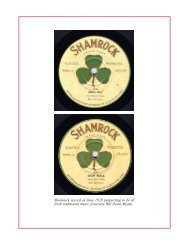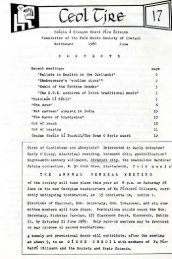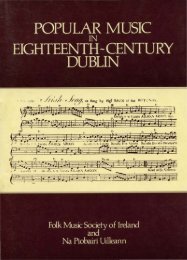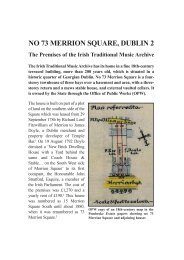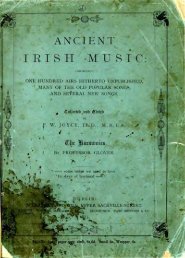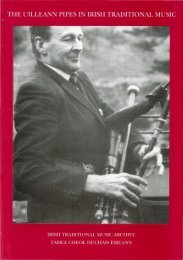Union Pipes - Irish Traditional Music Archive
Union Pipes - Irish Traditional Music Archive
Union Pipes - Irish Traditional Music Archive
Create successful ePaper yourself
Turn your PDF publications into a flip-book with our unique Google optimized e-Paper software.
15 COURTNEY’S ‘UNION PIPES’ AND THE TERMINOLOGY OF IRISH BELLOWS-BLOWN BAGPIPES<br />
references are found to <strong>Irish</strong> pipes that are or seem bellows-blown,<br />
some of them in British and north American sources. Visual<br />
illustrations of bellows-blown pipes begin to appear in Ireland from<br />
about 1750, and some instruments of the 1760s and 1770s survive in<br />
<strong>Irish</strong> museum collections and in private hands. They continued in<br />
these years before Courtney’s debut to be called ‘pipes’ in Ireland,<br />
or, when referred to more formally in newspapers and especially in<br />
the travel accounts of tourists, ‘<strong>Irish</strong> pipes’.<br />
In Britain, the otherness of <strong>Irish</strong> pipes and pipers, when they began<br />
to be noticed in print from the 1730s, 31 leads to them being normally<br />
described as ‘<strong>Irish</strong> pipes’ and ‘<strong>Irish</strong> pipers’. Again the terminology is<br />
confusing. Are they players of a familiar kind of mouth-blown or<br />
bellows-blown pipes who just happen to be <strong>Irish</strong>, or are they players<br />
of a distinct form of the instrument called ‘<strong>Irish</strong> pipes’? In 1743, as<br />
already mentioned, an <strong>Irish</strong> piper in London, John Geoghegan,<br />
introduced to the public the terms ‘Pastoral or New Bagpipe’ for<br />
bellows pipes, and defined a particular form of these pipes in some<br />
detail. But his new terms failed to be adopted generally, 32 and later in<br />
the same decade reference is again found in London to an ‘<strong>Irish</strong><br />
bagpipes player’. 33<br />
In an English letter of 10 July 1751 the ‘<strong>Irish</strong> Bag-pipes’ are<br />
unambiguously defined as a distinct bellows-blown instrument by<br />
31<br />
‘… a noted <strong>Irish</strong> Bagpiper, and Midnight Bully.’ Daily Post, London, 19 June<br />
1732, for example (reference courtesy Seán Donnelly).<br />
32<br />
However, after being noticed again by organologists in the 1950s and 1960s,<br />
Geoghegan’s ‘pastoral pipes’ term has come into currency within the last thirty<br />
years among an international subculture of makers and musicians interested in<br />
surviving instruments which resemble his, and in music which survives for<br />
them.<br />
33<br />
‘Committed... to the Gatehouse... Thomas Martin the famous <strong>Irish</strong> bagpipes<br />
player, for playing many tunes commonly used among the rebels..., Whitehall<br />
Evening Post or London Intelligencer, London, 27–29 Dec. 1748.



